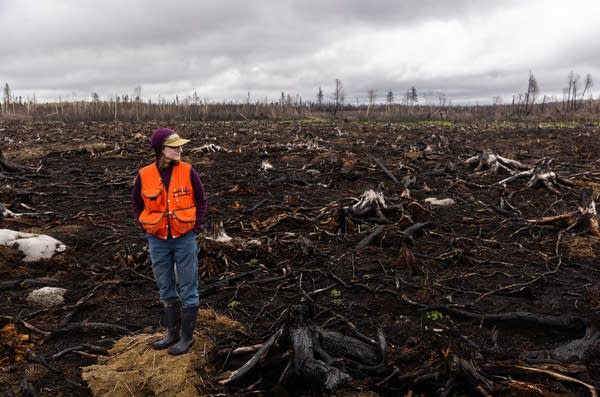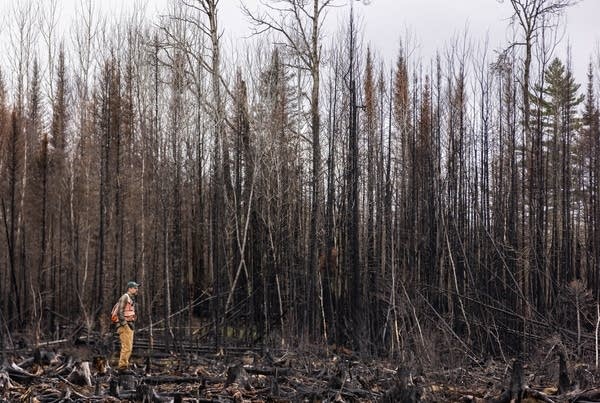Replanting a resilient forest in the ashes of the Greenwood Fire

Go Deeper.
Create an account or log in to save stories.
Like this?
Thanks for liking this story! We have added it to a list of your favorite stories.
Updated: 9:12 a.m.
Minnesota's Northwoods have evolved with wildfire. The boreal forest needs it to thrive.
Periodic fires clear out old vegetation to make room for new growth. They create a mosaic of wildlife habitats.
But it takes time for the forest to regenerate after a massive blaze like last summer's Greenwood Fire, which scorched more than 40 square miles of forest about an hour north of Two Harbors, Minn., and destroyed a dozen cabins.
Sometimes, it needs a helping hand.
Turn Up Your Support
MPR News helps you turn down the noise and build shared understanding. Turn up your support for this public resource and keep trusted journalism accessible to all.

Last week, crews from The Nature Conservancy finished planting 135,000 tiny tree seedlings across the footprint of the fire, an early step in helping bring the charred landscape back to life.
"We're seeing our forests stressed, and in a lot of places in pretty poor condition," said Jim Manolis, resilient forest program director for The Nature Conservancy.

The group’s work on the site of the Greenwood Fire is part of a broader effort to make northeastern Minnesota's forests better able to withstand stressors such as climate change, insects and disease.
One important way to do that is to make the forest more diverse, by planting a range of tree species. Manolis compares it to a diverse stock portfolio.
“And, you know, you want to have more diversity in your portfolio to survive change and stress. And forests are similar," he explained.

So, for example, if a disease or pest was to wipe out one species of trees, or if another kind of tree may not be able to survive a warmer climate decades from now, then, by planting a variety of species, the odds are better that at least some species will thrive, to ensure that the landscape of northern Minnesota remains forested.
"Diversity is like the super power of the forest,” said Manolis’ colleague, Nature Conservancy resilience forestry manager Chris Dunham. “We're really kind of using that diversity to hedge our bets.”

On a cool morning last week, a group of ten men — temporary workers from Guatemala and Honduras — fanned across a forest clearing near the small town of Isabella, Minn.
With one hand, each crew member wielded a heavy tool called a hoe dad to slice a hole in the wet earth. With their other hand, they grabbed a small tree seedling out of a bulky backpack, and stuffed it in the ground. A careful stamp of the boot finished each planting.
One tree planter, Dunham said, can plant about 2,500 trees in a single day.
"I mean if you try it out it's not easy,” he said. “It's an art. These guys are really professional athletes."

The planters hop over blackened stumps, charred trees and patches of soil and swamp that used to be covered in black spruce. When the Greenwood Fire roared through here last summer, in some places it completely burned away a layer of moss and peat on the forest floor that was several feet deep.

Now crews are replanting it with a mix of black spruce and tamarack, which also grows well in swampy areas.
DNR forester Anna Heruth said it's important to get trees established as quickly as possible. If the DNR waited for it to grow back naturally, she said there's a chance the trees wouldn't return at all.
"This is a lot of acres to just kind of hope for the seeds to reestablish itself,” Heruth said. “Also, because of the intensity of the fire, we don't know how much seed is actually in that duff layer. It could have gotten burned up with the intensity. So we want it to ensure that seedlings will come back."

The DNR is also using helicopters to drop seed over especially remote areas where the Greenwood Fire burned.
Additionally, the Superior National Forest has planted 10,000 trees at the McDougal Lake campground, and plans to plant additional trees in subsequent years.
The Nature Conservancy is partnering with the state and federal agencies, and also with Lake County, to plant a range of species across where the fire burned—white and black spruce, white and red pine and tamarack.
But they’re doing more than planting a diversity of different tree species. They’re also planting some tree seedlings that were grown in a slightly warmer climate.
In one plot of Superior National Forest land that burned near Minnesota Highway 2, the Nature Conservancy planted trees that were grown in northern Wisconsin. It’s a small step into a practice known as "assisted migration."
"We are seeing a warming climate, and we're seeing a need to look for the species and the seeds that are more adapted to warmer sites,” Manolis explained.
“We're taking baby steps with it, we're going one seed zone to the south. It's not that far, but it's a step, and we're doing a lot of monitoring and research on that. And so far, it seems to be working.”
Correction (June 1, 2022): An earlier version of this story misspelled Jim Manolis’ name. The story has been updated.



